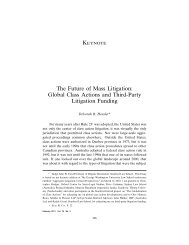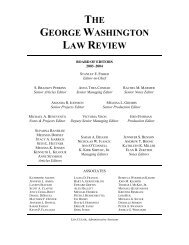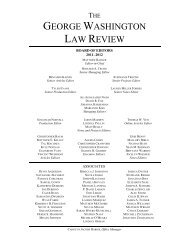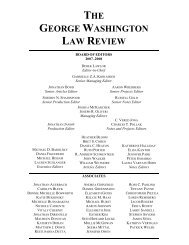View PDF - The George Washington Law Review
View PDF - The George Washington Law Review
View PDF - The George Washington Law Review
Create successful ePaper yourself
Turn your PDF publications into a flip-book with our unique Google optimized e-Paper software.
868 <strong>The</strong> <strong>George</strong> <strong>Washington</strong> <strong>Law</strong> <strong>Review</strong> [Vol. 78:846<br />
unfamiliar subject matter and to adopt a new style of thought. One<br />
judge remarked, “I don’t care where you have been. I don’t think<br />
anyone is qualified to be a federal district judge. . . . You simply cannot<br />
believe for starting what you don’t know.” 103 Another offers the<br />
view that it takes “between five to seven years” to become comfortable<br />
with the work. 104 Another significant aspect of the transition involves<br />
the social dynamics. <strong>The</strong> judicial role involves isolation, an<br />
effect that is magnified by past acquaintances’ perceived need to treat<br />
the new judge differently than they did before. 105 Federal Judges Revealed<br />
includes extensive quotes from the oral history of Judge Milton<br />
Schwartz concerning the transition to the bench, in which he relates,<br />
among other things, the change in his relationships with his lawyer<br />
friends and the solitude of the job:<br />
<strong>The</strong>re’s nobody to come to visit and you’ve just got your two<br />
law clerks and your secretary and the court reporter and the<br />
courtroom clerk. That’s all you can have to talk to. And it<br />
does get very lonesome. Lonely. And you don’t have this<br />
great collegiality of being able to trade thoughts and ideas<br />
back and forth. 106<br />
<strong>The</strong> materials in Federal Judges Revealed likewise demonstrate<br />
the divergent approaches that judges take to their task, especially at<br />
the trial-court level. Some judges characterize the position as being<br />
mostly passive and reactive, with the focus on making decisions and<br />
getting to the next case. 107 Others strive to be more of a presence and<br />
to take a more active role in shaping the matters before them. 108<br />
Some judges run a formal courtroom, 109 while others prefer to give a<br />
looser rein to the lawyers, 110 and some come across as borderline<br />
sadistic. 111<br />
Some of the more noteworthy anecdotes relate to the role that<br />
law clerks play. Although the depth of clerks’ involvement in the judi-<br />
103 DOMNARSKI, supra note 20, at 129 (quoting from the oral history of Judge Gene<br />
Brooks).<br />
104 Id. at 130 (quoting from the oral history of Judge Leon Higginbotham).<br />
105 Id. at 147–50.<br />
106 Id. at 140 (quoting from the oral history of Judge Milton Schwartz).<br />
107 Id. at 143–44.<br />
108 Id. at 163–69.<br />
109 Id. at 163–64 (quoting from the oral histories of Judges Myron Gordon and William<br />
Justice).<br />
110 Id. at 162–63 (quoting from the oral history of Judge William Beatty).<br />
111 Id. at 167–69 (quoting from the oral history of Judge Andrew Hauk), 213–16 (quoting<br />
from the oral histories of Judges James Moran and Luther Swygert (each of whom was speaking<br />
about the traits of other judges)).









